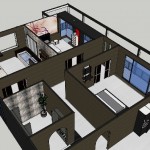 Are you the lucky owner of one of the hundreds of thousands of apartments in the Netherlands? Then you are also required to be and automatically a member of the Homeowners Association (HOA) of the apartment building. It is the job of the HOA – partly your job too – to keep the building in good condition. Reducing energy consumption is certainly a part of that you would think. This often requires a considerable investment and expertise. And that is exactly where the problem lies. HOA’s have neither. How do you break the deadlock?
Are you the lucky owner of one of the hundreds of thousands of apartments in the Netherlands? Then you are also required to be and automatically a member of the Homeowners Association (HOA) of the apartment building. It is the job of the HOA – partly your job too – to keep the building in good condition. Reducing energy consumption is certainly a part of that you would think. This often requires a considerable investment and expertise. And that is exactly where the problem lies. HOA’s have neither. How do you break the deadlock?
What problems stand in the way of implementing sustainability now?
- You always pay the same price every month to the HOA. A price that is usually determined by the number of square meters of your apartment in compared with the other homes. While the energy consumption per apartment is different, depending on the location in the building and your personal need for heat, ventilation, water and light.
- The reserves of an HOA are often too small for the substantial investments that are needed to renovate. Investments in sustainable energy and insulation maintenance of shell, roof and ground floor.
- The HOA has no ownership so can’t close a loan because the collateral is missing. More about that issue in the blog on Smart Financing.
- The average home owner has no more financial room to take out a new loan or increase an existing one. And the costs – named transaction costs – of those loans are high.
- Apart from the other issues, often everyone has to participate and agree in the investment to move ahead. Unanimity is hard to get.
- Despite their umbrella organisation, HOA lack the knowledge and experience to analyze, start up, outsource and manage a complicated sustainability project.
What solutions support implementing sustainability?
- Place the part of the building that is now the HOA’s responsible in a separate cooperation, association, foundation or private company. Members translated into shareholders are the real owners of the base building, like a real estate developer or investor. This building organisation can take out a loan for major investments with the base building as collateral.
- Make the buyer of the apartment full owner of the fit-out en related MEP systems (Mechanical, Electrical, Plumping) inside. Give him full ownership of this and the right to a mortgage. Now every change inside the apartment acquires the agreement of all inhabitants of the building.
- Recharge the investment cost of making sustainable of for instance the facade per apartment to the individual end user / owner, based on the savings in energy cost for that particular apartment. The returns and savings depend primarily on the kind of apartment. Think about the differences in energy use of a corner apartment or one directly under the building roof;
- How dow you deal with how it is used? A question even more difficult – because being more subjective – to answer. Often it is better nog te take that into consideration and calculation and to remain that as responsibility of the actual apartment owners.
What particular problems do you run into with your HOA? Share your frustrations and experiences in the comment field below. Together will use them to give politicians insights on how frustrating the current HOA model is and how it blocks to implementing sustainability.
Take the next step and share your experiences
Do you want to take a next step? Come to the FREE* Masterclass. We will work with practical tools to instantly implement the actions of my ebook in your organizational, fiscal or financial projects and organization.
Join the conversation
Do you know how to build that new way and what you need? How do you help Home Owner Associations on this? Share it in the comments below.
To your health and wellbeing,
Remko Zuidema



